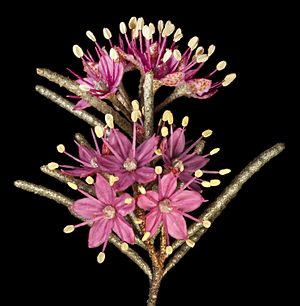Phebalium canaliculatum facts for kids
Quick facts for kids Phebalium canaliculatum |
|
|---|---|
 |
|
| Near Lake Moore, Western Australia | |
| Scientific classification | |
| Genus: |
Phebalium
|
| Species: |
canaliculatum
|
| Synonyms | |
|
Eriostemon canaliculatus F.Muell. & Tate |
|
The Phebalium canaliculatum is a type of upright shrub. It grows only in the southwest part of Western Australia. This plant is often covered with shiny, silver-colored and rusty-colored scales. It has thin, round leaves. Its flowers are dark pink to light purple and grow in small clusters at the ends of its branches.
Contents
About the Phebalium Plant
The Phebalium canaliculatum is an upright shrub. It usually grows to be about 0.4 to 2 meters (about 1.3 to 6.5 feet) tall. The plant is mostly covered in silvery and rust-colored scales.
Its leaves are shaped like thin tubes or are slightly flat. They are about 25 millimeters (1 inch) long. The leaves sit on a very short stalk called a petiole.
The flowers are dark pink to light purple. They grow in small, umbrella-shaped clusters called umbels. These clusters are found at the very ends of the plant's small branches. Each flower has its own tiny stalk, called a pedicel, which is about 4 to 7 millimeters long.
The plant has small leaf-like parts called sepals. These sepals are about 1 millimeter long and are joined together for about half their length. They are scaly on the outside but smooth on the inside. The flower's petals are oval-shaped. They are about 4 to 5 millimeters long and 2 to 3 millimeters wide. The outside of the petals is covered with silvery scales.
Inside the flower, the stamens have pale purple threads called filaments. These filaments hold yellow parts called anthers. The plant usually flowers in May or from July to October.
How it Got its Name
This plant was first officially described in 1896. Two scientists, Ferdinand von Mueller and Ralph Tate, wrote about it. They used plant samples collected by James Drummond. These samples were found near a place called "Ularing" during an expedition by Ernest Giles.
They first named the plant Eriostemon canaliculatus. This description was published in a scientific paper called Transactions of the Royal Society of South Australia. Later, in 1958, another scientist named James Hamlyn Willis changed its name. He renamed it Phebalium canaliculatum in a publication called The Victorian Naturalist.
Where it Lives and Grows
The Phebalium canaliculatum plant grows in specific areas. You can find it on flat, sandy areas called sandplains. It also grows on the sides of hills, which are called hillslopes. Sometimes, it even grows on rocky areas.
This plant is found in shrubland or mallee areas. These are types of plant communities with many shrubs and small trees. Its range stretches between Wongan Hills, Sandstone, and Kalgoorlie in Western Australia.
Its Conservation Status
The Western Australian Government's Department of Parks and Wildlife has looked at the Phebalium canaliculatum. They have decided that this plant is "not threatened." This means it is not currently in danger of disappearing.

